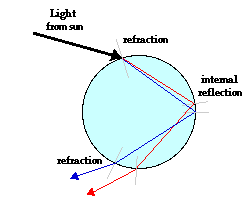WATER
PHYSICS!
RAINBOWS!

water droplets disperse and reflect light, thus, creating a rainbow.
REFLECTION!

the reflection of water waves is related to physics considering the fact the waves are reflected due to the wave fronts and wave direction in which water has to obey the rules of reflection.
DENSITY!
water is used as reference for density of different liquids.
VISCOSITY!
velocity of light is dependent on the density of water in which water needs to make electricity.
mirrors
plane mirror: mirror with plane flat screen surface
curved mirrors: used to determine magnified and diminished images.
to focus light
determine distorted images
Subtopic
BIOLOGY!
WATER AND BIOLOGICAL SYSTEMS!
water is one of the most significant molecules mankind has ever encountered, and with this molecule, eco systems and biological systems are able to sustain themselves.
NATURE!
water doesn't only exit within nature, but also covers 75 percent of our entire planet, while also occupying 78 percent of our bodies.
WATER CYCLE!

when the clouds get heavy, they fall down onto the earth in the form of either rain, hail, snow or sleet. and as it lands back down, it falls back into the oceans, rivers and lakes, and eventually land, which begins the entire cycle once again as it evaporates and goes through the condensation stage and last but not least precipitation stage. it keeps on repeating.
muscular system
skeletal system
bones
flexible
muscle
tissue
cardio vascular system
delivers nutrients and oxygen to cells throughout the entire torso
consists of the heart and blood vessels
arteries carry blood to the heart
respitory system
lungs takes in oxygen and expels oxygen.
digestive system
your food is digested through this process
food goes down the esophagus and to the stomach. the stomach helps digest the food.
the food when breaken down, travels throughout the body as nutrients, and so the waste goes through the small intestine which leads to the large intestine.
the waste is then transported through the rectum.
CLIMATE CHANGE!
ACID RAIN!
due to atmospheric pollution acidic rain is produced and it can typically harm the environment. acidic rain is caused by the excessive burning of fossil fuels and waste gasses from sulphur and nitrogen oxides which afterwards mix in with the atmospheric acids (forming acids later on).
WATER LEVELS!

lake levels are expected (as scientists have proven) to demolish once more moisture evaporates due to the rising of warm temperature and less coverage of ice.
small water streams will dry up due to the change of temperature. the areas of wetland will be reduced and less wildlife habitats will be exhibited.
and increase of flooding and droughts will increase once climate change interferes with water or the temperature, let alone.
GLACIERS!
evident climate change is presented once glaciers melt, striking signs of arising temperature and whatnot. scientists believe that more than 50 percent of glacier ice has melted away during the last century.
CHEMISTRY!
ELEMENT!
water is a pure substance containing hydrogen and oxygen which are both located on the periodic table and are elements. hydrogen and oxygen when combined together create water, also known as H2O.
SOLUTION!
you can make solutions with water, such as
the saline water solution. and you can do that by
dissolving NaCl in H2O (water). this relates to chemistry because in chemistry, two or more substances mixed together form a homogeneous mixture, and water is also a pure substance which can be added to create various mixtures.
POLARITY OF WATER
the polarity of water is significant because it is
in charge of helping other polar molecules dissolve with ease, for example, the following compounds such as sugar and salt.
ionic compounds dissolve in water so that they can form ions
periodic table
table of elements
118 elements
atomic number and atomic mass are determined by looking at this table.

